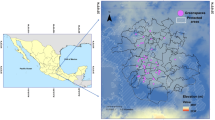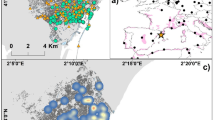Abstract
Identifying urban areas with a high potential for providing pollination is essential for the management of urban agriculture. Urban green spaces have a vital role in providing nesting and foraging habitats for pollinators, and they act as pollinator refuges in cities. Therefore, regions adjacent to green spaces can host agricultural products in dire need of pollinators for their produce. To determine the suitable areas for urban agriculture according to the proximity to urban green spaces, we used two models, the Lonsdorf and the graph theory models. The Lonsdorf model focuses more on the capacity of the patches to support pollinators but graph theory methods on the connectivity between the patches. According to graph theory, a set of patches with functional connectivity for pollinators can lead to the formation of clusters around them. Each of these clusters has a certain potential for supplying pollination for urban agricultural products. Both models estimate the capacity of patches in supplying pollination services based on the distances at which bees can fly. To test the robustness of the results of each model, we perform both models at distances of 500, 700, 1000, and 1500 m as maximum foraging distances of bees. Our results suggested that both models showed similar results in determining suitable areas for urban agriculture. Both models showed that the northern and northeastern regions of Tehran were the most suitable areas for urban agriculture and have a high potential to support the pollinator population. In contrast, the central regions had a low capacity to maintain pollinators for urban agriculture, and had little support from wild bees for pollination. Our results also showed that the conversion of bare lands into green spaces could significantly increase the pollination level in Tehran city.
Access this article
We’re sorry, something doesn't seem to be working properly.
Please try refreshing the page. If that doesn't work, please contact support so we can address the problem.







Similar content being viewed by others
Data Availability
Data are available on request from the authors only based on logical requests.
References
Baldock KC, Goddard MA, Hicks DM, Kunin WE, Mitschunas N, Osgathorpe LM, Potts SG, Robertson KM, Scott AV, Stone GN (2015) Where is the UK’s pollinator biodiversity? The importance of urban areas for flower-visiting insects, Proceedings of the Royal Society B: Biological Sciences282(1803):20142849
Bellamy CC, van der Jagt AP, Barbour S, Smith M, Moseley D (2017) A spatial framework for targeting urban planning for pollinators and people with local stakeholders: A route to healthy, blossoming communities? Environ Res 158:255–268
Bennett AB, Lovell S (2019) Landscape and local site variables differentially influence pollinators and pollination services in urban agricultural sites. PLoS ONE 14(2):e0212034
Bergerot B, Fontaine B, Renard M, Cadi A, Julliard R (2010) Preferences for exotic flowers do not promote urban life in butterflies. Landsc Urban Plann 96(2):98–107
Bhattacharya M, Primack RB, Gerwein J (2003) Are roads and railroads barriers to bumblebee movement in a temperate suburban conservation area? Biol Conserv 109(1):37–45
Brandes U, Delling D, Gaertler M, Gorke R, Hoefer M, Nikoloski Z, Wagner D (2007) On modularity clustering. IEEE Trans Knowl Data Eng 20(2):172–188
Colasanti KJ, Hamm MW, Litjens CM (2012) The City as an” Agricultural Powerhouse”? Perspectives on Expanding Urban Agriculture from Detroit, Michigan. Urban Geogr 33(3):348–369
Davis AY, Lonsdorf EV, Shierk CR, Matteson KC, Taylor JR, Lovell ST, Minor ES (2017) Enhancing pollination supply in an urban ecosystem through landscape modifications. Landsc Urban Plann 162:157–166
Everaars J, Settele J, Dormann CF (2018) Fragmentation of nest and foraging habitat affects time budgets of solitary bees, their fitness and pollination services, depending on traits: results from an individual-based model. PLoS ONE 13(2):e0188269
Foltête J-C, Clauzel C, Vuidel G (2012) A software tool dedicated to the modelling of landscape networks. Environ Model Softw 38:316–327
Fuller RA, Gaston KJ (2009) The scaling of green space coverage in European cities. Biol Lett 5(3):352–355
Greenleaf SS, Williams NM, Winfree R, Kremen C (2007) Bee foraging ranges and their relationship to body size. Oecologia 153(3):589–596
Groff SC, Loftin CS, Drummond F, Bushmann S, McGill B (2016) Parameterization of the InVEST crop pollination model to spatially predict abundance of wild blueberry (Vaccinium angustifolium Aiton) native bee pollinators in Maine, USA. Environ Model Softw 79:1–9
Harrison T, Winfree R (2015) Urban drivers of plant-pollinator interactions. Funct Ecol 29(7):879–888
Hennig EI, Ghazoul J (2012) Pollinating animals in the urban environment. Urban Ecosyst 15(1):149–166
Holzschuh A, Dudenhöffer J-H, Tscharntke T (2012) Landscapes with wild bee habitats enhance pollination, fruit set and yield of sweet cherry. Biol Conserv 153:101–107
Jenks GF (1977) Optimal data classification for choropleth maps, Department of Geographiy, University of Kansas Occasional Paper
Kremen C, Ostfeld RS (2005) A call to ecologists: measuring, analyzing, and managing ecosystem services. Front Ecol Environ 3(10):540–548
Lerman SB, Contosta AR, Milam J, Bang C (2018) To mow or to mow less: Lawn mowing frequency affects bee abundance and diversity in suburban yards. Biol Conserv 221:160–174
Levé M, Baudry E, Bessa-Gomes C (2019) Domestic gardens as favorable pollinator habitats in impervious landscapes. Sci Total Environ 647:420–430
Lonsdorf E, Kremen C, Ricketts T, Winfree R, Williams N, Greenleaf S (2009) Modelling pollination services across agricultural landscapes. Ann Botany 103(9):1589–1600
Lovell ST (2010) Multifunctional urban agriculture for sustainable land use planning in the United States. Sustainability 2(8):2499–2522
Lowenstein DM, Matteson KC, **ao I, Silva AM, Minor ES (2014) Humans, bees, and pollination services in the city: the case of Chicago, IL (USA). Biodivers Conserv 23(11):2857–2874
Lowenstein DM, Matteson KC, Minor ES (2015) Diversity of wild bees supports pollination services in an urbanized landscape. Oecologia 179(3):811–821
Matteson KC, Langellotto GA (2009) Bumble bee abundance in New York City community gardens: implications for urban agriculture. Cities and the Environment (CATE) 2(1):5
Matteson K, Grace JB, Minor E (2013) Direct and indirect effects of land use on floral resources and flower-visiting insects across an urban landscape. Oikos 122(5):682–694
Mitchell MG, Bennett EM, Gonzalez A (2013) Linking landscape connectivity and ecosystem service provision: current knowledge and research gaps. Ecosystems 16(5):894–908
Mitchell M (2014) The Effects of Landscape Structure and Biodiversity on Ecosystem Services. McGill University Libraries
Mok H, Williamson V, Grove J, Burry K, Barker S, Hamilton A (2014) Strawberry fields forever? Urban agriculture in developed countries: a review. Agron Sustain Dev 34(1):21–43
Newman ME (2006) Modularity and community structure in networks, Proceedings of the national academy of sciences103(23):8577–8582
Nogué S, Long PR, Eycott AE, de Nascimento L, Fernández-Palacios JM, Petrokofsky G, Vandvik V, Willis KJ (2016) Pollination service delivery for European crops: Challenges and opportunities. Ecol Econ 128:1–7
Olsson O, Brown JS, Helf KL (2008) A guide to central place effects in foraging. Theor Popul Biol 74(1):22–33
Olsson O, Bolin A (2014) A model for habitat selection and species distribution derived from central place foraging theory. Oecologia 175(2):537–548
Pascual-Hortal L, Saura S (2006) Comparison and development of new graph-based landscape connectivity indices: towards the priorization of habitat patches and corridors for conservation. Landscape Ecol 21(7):959–967
Pellissier V, Maurel N, Machon N (2013) Multi-scale assessment of pollination of Lotus corniculatus (L.) in a peri-urban fringe. Plant Ecol Divers 6(2):195–203
Perennes M, Diekötter T, Groß J, Burkhard B (2021) A hierarchical framework for map** pollination ecosystem service potential at the local scale. Ecol Model 444:109484
Prospects WU (2014) The 2014 Revision, Highlights (ST/ESA/SERA/352.)
Pyke GH (1980) Optimal foraging in bumblebees: calculation of net rate of energy intake and optimal patch choice. Theor Popul Biol 17(2):232–246
Quistberg RD, Bichier P, Philpott SM (2016) Landscape and local correlates of bee abundance and species richness in urban gardens. Environ Entomol 45(3):592–601
Rahimi E, Barghjelveh S, Dong P (2021) Using the Lonsdorf model for estimating habitat loss and fragmentation effects on pollination service. Ecol Processes 10(1):1–13
Rahimi E, Barghjelveh S, Dong P (2022) A review of diversity of bees, the attractiveness of host plants and the effects of landscape variables on bees in urban gardens. Agric Food Secur 11(1):1–11
Saha M, Eckelman MJ (2017) Growing fresh fruits and vegetables in an urban landscape: A geospatial assessment of ground level and rooftop urban agriculture potential in Boston, USA. Landsc Urban Plann 165:130–141
Su Z, Li X, Zhou W, Ouyang Z (2015) Effect of landscape pattern on insect species density within urban green spaces in Bei**g, China. PLoS ONE 10(3):e0119276
Taylor JR, Lovell ST (2012) Map** public and private spaces of urban agriculture in Chicago through the analysis of high-resolution aerial images in Google Earth. Landsc urban Plann 108(1):57–70
Theodorou P, Radzevičiūtė R, Settele J, Schweiger O, Murray TE, Paxton RJ (2016) Pollination services enhanced with urbanization despite increasing pollinator parasitism, Proceedings of the Royal Society B: Biological Sciences283(1833):20160561
Theodorou P, Albig K, Radzevičiūtė R, Settele J, Schweiger O, Murray TE, Paxton RJ (2017) The structure of flower visitor networks in relation to pollination across an agricultural to urban gradient. Funct Ecol 31(4):838–847
Theodorou P, Radzevičiūtė R, Lentendu G, Kahnt B, Husemann M, Bleidorn C, Settele J, Schweiger O, Grosse I, Wubet T (2020) Urban areas as hotspots for bees and pollination but not a panacea for all insects. Nat Commun 11(1):1–13
Tornaghi C (2014) Critical geography of urban agriculture. Prog Hum Geogr 38(4):551–567
Vanbergen AJ, Initiative tIP (2013) Threats to an ecosystem service: pressures on pollinators. Front Ecol Environ 11(5):251–259
Wenzel A, Grass I, Belavadi VV, Tscharntke T (2020) How urbanization is driving pollinator diversity and pollination–A systematic review. Biol Conserv 241:108321
Yang F, Ignatieva M, Wissman J, Ahrné K, Zhang S, Zhu S (2019) Relationships between multi-scale factors, plant and pollinator diversity, and composition of park lawns and other herbaceous vegetation in a fast growing megacity of China. Landsc Urban Plann 185:117–126
Zulian G, Paracchini ML, Maes J, Liquete C (2013) ESTIMAP: Ecosystem services map** at European scale. Publications Office of the European Union, Luxembourg
Zurbuchen A, Landert L, Klaiber J, Müller A, Hein S, Dorn S (2010) Maximum foraging ranges in solitary bees: only few individuals have the capability to cover long foraging distances. Biol Conserv 143(3):669–676
Funding
There are no financial conflicts of interest to disclose.
Author information
Authors and Affiliations
Corresponding author
Ethics declarations
Ethics approval and consent to participate
Not applicable.
Consent for publication
Not applicable.
Competing interests
The authors declare that they have no competing interests.
Additional information
Publisher’s Note
Springer Nature remains neutral with regard to jurisdictional claims in published maps and institutional affiliations.
Rights and permissions
Springer Nature or its licensor holds exclusive rights to this article under a publishing agreement with the author(s) or other rightsholder(s); author self-archiving of the accepted manuscript version of this article is solely governed by the terms of such publishing agreement and applicable law.
About this article
Cite this article
Rahimi, E., Barghjelveh, S. & Dong, P. Estimating the pollination supply of urban green spaces to determine suitable areas for urban agriculture in the city of Tehran. Urban Ecosyst 26, 19–30 (2023). https://doi.org/10.1007/s11252-022-01289-6
Accepted:
Published:
Issue Date:
DOI: https://doi.org/10.1007/s11252-022-01289-6




